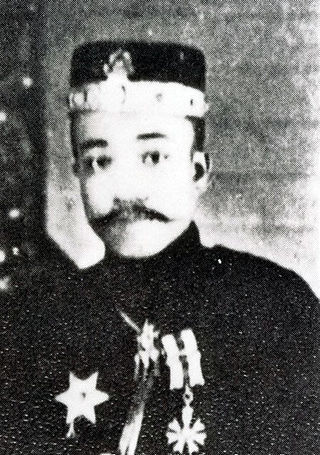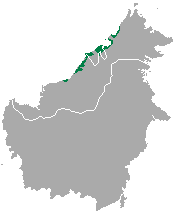
Brunei, formally Brunei Darussalam, is a country located on the north coast of the island of Borneo in Southeast Asia. Apart from its South China Sea coast, it is completely surrounded by the Malaysian state of Sarawak. It is separated into two parts by the Sarawak district of Limbang. Brunei is the only sovereign state entirely on Borneo; the remainder of the island is divided between Malaysia and Indonesia. As of 2020, its population was 460,345, of whom about 100,000 live in the capital and largest city, Bandar Seri Begawan. The government is an absolute monarchy ruled by its Sultan, entitled the Yang di-Pertuan, and implements a combination of English common law and sharia law, as well as general Islamic practices.
Malaysian Malay, also known as Standard Malay, BahasaMalaysia, or simply Malay, is a standardized form of the Malay language used in Malaysia. Malaysian Malay is standardized from the Johore-Riau dialect of Malay. It is spoken by much of the Malaysian population, although most learn a vernacular form of Malay or another native language first. Malay is a compulsory subject in primary and secondary schools.

Muhammad Jamalul Alam II was the 26th Sultan of Brunei from 10 May 1906 until his death in 1924.

Victoria, sometimes known as Bandar Labuan, is the capital of the Federal Territory of Labuan in Malaysia, an island group off the north coast of Borneo. It is in the southeast corner of Labuan and its Malay name, Bandar Victoria, is commonly used to honour the reign of Queen Victoria. The town is an urban district within the wider city limits of Victoria which includes Labuan Port, a sheltered deep-water harbour which is an important trans-shipment point for Brunei Darussalam, northern Sarawak and western Sabah.

The Kedayan are an ethnic group residing in Brunei, Federal Territory of Labuan, southwest of Sabah, and north of Sarawak on the island of Borneo. According to the Language and Literature Bureau of Brunei, the Kedayan language is spoken by about 30,000 people in Brunei, and it has been claimed that there are a further 46,500 speakers in Sabah and 37,000 in Sarawak. In Sabah the Kedayan mainly live in the cities of Sipitang, Beaufort, Kuala Penyu and Papar. In Sarawak the Kedayans mostly reside in Lawas, Limbang, Miri and the Subis area. The Kedayan people are also regarded as a sub-ethnic group of the Klemantan Dayak people.

Hashim Jalilul Alam Aqamaddin was the 25th Sultan of Brunei from 30 May 1885 to 10 May 1906.

The Ministry of Education is a ministry of the Government of Malaysia that is responsible for education system, compulsory education, pre-tertiary education, technical and vocational education and training (TVET), curriculum standard, textbook, standardised test, language policy, translation, selective school, comprehensive school.

Mukim Kuala Belait is a mukim in Belait District, Brunei. The population was 31,308 in 2016. The mukim encompasses Kuala Belait, the administrative town of the district.

In the history of Brunei, the Sultanate of Brunei or simply Brunei was a Malay sultanate, centred in Brunei on the northern coast of Borneo island in Southeast Asia. Brunei became a sovereign state around the 15th century, when it grew substantially after the fall of Malacca to the Portuguese, extending throughout coastal areas of Borneo and the Philippines, before it declined in the 17th and 18th centuries. The first ruler or sultan of Brunei was a Muslim. It became a British protectorate in the 19th century.

Lun Bawang or Lundayeh is the language spoken by the Lun Bawangs. It belongs to the Malayo-Polynesian family.

The Brunei Malay language, or Kedayan is the most widely spoken language in Brunei and a lingua franca in some parts of Sarawak and Sabah, such as Labuan, Limbang, Lawas, Sipitang and Papar. Though Standard Malay is promoted as the official national language of Brunei, Brunei Malay is socially dominant and it is currently replacing the minority languages of Brunei, including the Dusun and Tutong languages. It is quite divergent from Standard Malay to the point where it is almost mutually unintelligible with it. Although the idea that Brunei Malay might be classified as a creole language has been discredited, it does bear considerable similarities to East Indonesian Malay-based creole languages.
The Tutong language, also known as Basa Tutong, is a language spoken by approximately 17,000 people in Brunei. It is the main language of the Tutong people, the majority ethnic group in the Tutong District of Brunei.

Kelupis is a traditional kuih for the Bruneian Malay people in the country of Brunei and in the states of Sabah and Sarawak in Malaysia. It is also a traditional snack for the Bisaya people as the three ethnics are ethnically related which is Lun Bawang/Lundayeh also create this kelupis especially on the wedding ceremony.

The Language and Literature Bureau is the Bruneian language authority of the country's official language Malay. It is also the operator of public libraries in the country. It was established in 1960 and is now a government department under the Ministry of Culture, Youth and Sports.

Zakaria Ariffin is a Malaysian playwright, theater director and educator.
Adai-adai dance is a traditional dance of Bruneian Malay ethnic group in Brunei Darussalam, Sabah and Labuan in Malaysia, this dance is based on the life of the fishermen. This dance tells the story of a group of fishermen who go fishing in the sea while the women wait for their return to the beach to help collect the catch that will be obtained.
The Tutong people are an ethnic group native to Brunei, mainly in Tutong District. They traditionally speak the Tutong language. They are officially recognised as one of the seven ethnic groups of the Bruneian Malay race.

The Istana Kota Manggalela, also known as Istana Manggalela, is one of the temporary official residences of the then Sultan of Brunei, Omar Ali Saifuddien III. The palace is located at Jalan Maulana, Kuala Belait, Belait District, Brunei. The building has become a tourist attraction and historical site in the present day.

Cermin Island is an islet at the mouth of Brunei River in the Mukim Kota Batu, Brunei-Muara District, Brunei. During the Brunei Civil War, a battle unfolded on the island and it's sometimes referred to as the Peperangan Pulau Cermin. A proposal for an 5 hectares protection status to be implemented on the island. The island is home to sundry vegetation and swamp forests.

Sufri Bolkiah ibni Omar Ali Saifuddien III is a member of the royal family of Brunei. He is the third son of Omar Ali Saifuddien III, the 28th Sultan of Brunei, and Raja Isteri (Queen) Pengiran Anak Damit. He is also the President of the Brunei Darussalam National Olympic Council (BDNOC) since 2010.


















